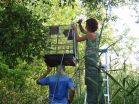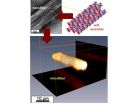New, faster therapeutic hypothermia techniques
Needed to optimize cardioprotection following a heart attack
2014-10-23
(Press-News.org) New Rochelle, NY, October 23, 2014–Rapid lowering of body temperature following an acute myocardial infarction (MI) can be an effective therapeutic strategy to minimize damage to the heart muscle caused by the loss and restoration of blood flow to the heart. While hypothermia shows clinical promise, current methods to cool the heart are insufficient. Faster, more effective techniques are needed to realize the full cardioprotective potential of this emerging intervention, as described in an article in Therapeutic Hypothermia and Temperature Management, a peer-reviewed journal from Mary Ann Liebert, Inc., publishers. The article is available free on the Therapeutic Hypothermia and Temperature Management website at http://online.liebertpub.com/doi/full/10.1089/ther.2014.0016 until November 23, 2014.
In the article "Hypothermia in the Setting of Experimental Acute Myocardial Infarction: A Comprehensive Review", Michael J. Herring and coauthors from Good Samaritan Hospital and Keck School of Medicine, University of Southern California (Los Angeles, CA) and Harbor-UCLA Medical Center (Torrance, CA) examine the benefits and limitations of past and current methods of delivering hypothermia. These include topical regional hypothermia, an open-chest method of cooling the heart; endovascular cooling using a heat exchange balloon catheter to cool the blood that flows through the heart; surface cooling with blankets or convective-immersion therapy; and other methods.
"This timely review on the use of therapeutic hypothermia targeting myocardial necrosis emphasizes the need for additional investigations to maximize the benefits of this experimental therapy in promoting recovery in this patient population," says W. Dalton Dietrich, PhD, Editor-in-Chief of Therapeutic Hypothermia and Temperature Management and Kinetic Concepts Distinguished Chair in Neurosurgery, Professor of Neurological Surgery, Neurology and Cell Biology, University of Miami Leonard M. Miller School of Medicine.
INFORMATION:
About the Journal
Therapeutic Hypothermia and Temperature Management provides a strong multidisciplinary forum covering all aspects of hypothermia and temperature considerations relevant to this exciting field, including its application in cardiac arrest, spinal cord and traumatic brain injury, stroke, and burns. Novel findings from translational preclinical investigations as well as clinical studies and trials are featured in peer-reviewed articles, state-of-the-art review articles, provocative roundtable discussions, clinical protocols, and best practices. Therapeutic Hypothermia and Temperature Management is the journal of record, published online with Open Access options and in print. Tables of content and a sample issue may be viewed on the Therapeutic Hypothermia and Temperature Management website at http://www.liebertpub.com/ther.
About the Publisher
Mary Ann Liebert, Inc., publishers is a privately held, fully integrated media company known for establishing authoritative peer-reviewed journals in many promising areas of science and biomedical research, including Journal of Neurotrauma and Brain Connectivity. Its biotechnology trade magazine, Genetic Engineering & Biotechnology News (GEN), was the first in its field and is today the industry's most widely read publication worldwide. A complete list of the firm's 80 journals, books, and newsmagazines is available on the Mary Ann Liebert, Inc., publishers website at http://www.liebertpub.com.
[Attachments] See images for this press release:

ELSE PRESS RELEASES FROM THIS DATE:
2014-10-23
CHAMPAIGN, Ill. — A new study finds that most U.S. adults fail to meet recommended daily levels of 10 key nutrients, and those with disabilities have even worse nutrition than average.
An estimated 10 to 25 percent of U.S. adults fit into one or more category of disability, from those who have difficulties with activities of daily living, such as dressing, bathing and eating, to those who cannot use their legs or struggle to accomplish routine tasks, such as money management or household chores.
To determine how these physical or mental difficulties can affect ...
2014-10-23
URBANA, Ill. – Although it would seem logical that large numbers of roosting birds would attract more mosquitoes that carry West Nile virus and contract the disease when bitten, recent research at the University of Illinois found the opposite to be true. That is, when large groups of birds roost together the chances that an individual bird will get bitten by mosquitoes carrying West Nile virus and subsequently contract the disease actually go down.
"Our study is the first field-based evidence to support what's called the 'encounter-dilution effect' acting in a ...
2014-10-23
COLUMBUS, Ohio: Astronomers have gotten the closest look yet at what happens when a black hole takes a bite out of a star—and the star lives to tell the tale.
We may think of black holes as swallowing entire stars—or any other object that wanders too close to their immense gravity. But sometimes, a star that is almost captured by a black hole escapes with only a portion of its mass torn off. Such was the case for a star some 650 million light years away toward Ursa Major, the constellation that contains the "Big Dipper," where a supermassive black hole tore ...
2014-10-23
Using a technique that illuminates subtle changes in individual proteins, chemistry researchers at Cornell University have uncovered new insight into the underlying causes of Amyotrophic Lateral Sclerosis (ALS).
Brian Crane, professor of chemistry and chemical biology, led one study and co-authored a follow-up on a spectroscopic method that detects subtle changes to copper-containing proteins in solution. He and Jack Freed, professor of physical chemistry, have developed the method together with Petr Borbat, associate director of Cornell's National Biomedical Center for ...
2014-10-23
ITHACA, N.Y. – To solve a mental puzzle, the brain's executive control network for externally focused, goal-oriented thinking must activate, while the network for internally directed thinking like daydreaming must be turned down to avoid interference – or so we thought.
New research led by Cornell University neuroscientist Nathan Spreng shows for the first time that engaging brain areas linked to so-called "off-task" mental activities (such as mind-wandering and reminiscing) can actually boost performance on some challenging mental tasks. The results advance ...
2014-10-23
Researchers at the New York University Polytechnic School of Engineering have broken new ground in the development of proteins that form specialized fibers used in medicine and nanotechnology. For as long as scientists have been able to create new proteins that are capable of self-assembling into fibers, their work has taken place on the nanoscale. For the first time, this achievement has been realized on the microscale—a leap of magnitude in size that presents significant new opportunities for using engineered protein fibers.
Jin Kim Montclare, an associate professor ...
2014-10-23
In this image taken by the Aqua satellite of the southern United States actively burning areas as detected by MODIS's thermal bands are outlined in red. Each red hot spot is an area where the thermal detectors on the MODIS instrument recognized temperatures higher than background. When accompanied by plumes of smoke, as in this image, such hot spots are diagnostic for fire. These fires are a combination of small wildfires and prescribed fires. On the U.S. Forest Service website a prescribed fire is set to reduce tree overcrowding, revive fire-dependent species and reduce ...
2014-10-23
Despite a dramatic increase in public awareness and anti-bullying legislation nationwide, the prevalence of bullying is still one of the most pressing issues facing our nation's youth, according to a report by researchers from Clemson University and Professional Data Analysts Inc., and published by the Hazelden Foundation.
"Bullying continues to affect a great number of children in all age groups, with the highest prevalence observed in third and fourth grades, where roughly 22 percent of schoolchildren report that they are bullied two or three times or more per month," ...
2014-10-23
A new test, developed by University of British Columbia researchers, could help physicians predict within an hour if a patient will develop severe sepsis so they can begin treatment immediately.
Sepsis, a syndrome caused by infection, leads to organ failure and is responsible for up to five million deaths annually. There are 18 million cases of sepsis worldwide every year.
The discovery could cut back on the lengthy diagnostic time usually required to confirm if a patient is suffering from sepsis and increase the odds that they will respond to treatment.
"We identified ...
2014-10-23
Scientists have found a molecule that could potentially accelerate clinical trials to combat autoimmune diseases.
Researchers from the Australian Regenerative Medicine Institute (ARMI) at Monash University and the European Molecular Biology Laboratory (EMBL) in Italy believe the molecule, called insulin-like growth factor-1 (IGF-1), could play a key role.
Autoimmune diseases occur when a group of immune cells called pro-inflammatory T-effector cells become sensitised to specific cells in the body, identifying them as foreign and attacking them as if they were invading ...
LAST 30 PRESS RELEASES:
[Press-News.org] New, faster therapeutic hypothermia techniques
Needed to optimize cardioprotection following a heart attack




